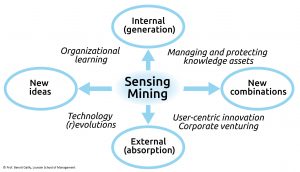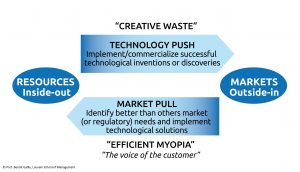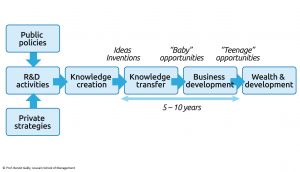 R&D is not enough. Significant R&D spending might be necessary for some firms to develop new technologies but certainly does not guarantee their innovation success. Identifying innovation opportunities requires learning about new combinations of new or existing technologies with new or existing needs.
R&D is not enough. Significant R&D spending might be necessary for some firms to develop new technologies but certainly does not guarantee their innovation success. Identifying innovation opportunities requires learning about new combinations of new or existing technologies with new or existing needs.
 The triggers of innovation opportunities which firms should proactively exploit include internal sources such as new knowledge, challenging routines and serendipity, and external sources such as changes in markets, industry and environmental constraints.
The triggers of innovation opportunities which firms should proactively exploit include internal sources such as new knowledge, challenging routines and serendipity, and external sources such as changes in markets, industry and environmental constraints.
 Sizeable innovation opportunities do not pop up out of the blue. Organizations must invest time and resources to combine, integrate and mature innovation ideas into potential opportunities. They should also pursue already emerging opportunities and focus on scaling them up.
Sizeable innovation opportunities do not pop up out of the blue. Organizations must invest time and resources to combine, integrate and mature innovation ideas into potential opportunities. They should also pursue already emerging opportunities and focus on scaling them up.
Bibliography
R&D is not enough
Keywords: market pull, R&D as a source of innovation, technology, technology push
- (Book) Johnson, S. (2010) Where good ideas come from, Penguin Books.
- (Book) Nonaka, I., & Takeuchi, H. (1995). The knowledge-creating company: How Japanese companies create the dynamics of innovation. Oxford University Press.
- (Video) “Where good ideas come from” by Steven Johnson
- (Article) Ahmadpoor, M., & Jones, B. F. (2017). The dual frontier: Patented inventions and prior scientific advance. Science, 357(6351), 583-587.
- (Article) Arora, A., Belenzon, S., & Patacconi, A. (2018). The decline of science in corporate R&D. Strategic Management Journal, 39(1), 3-32.
- (Article) Atuahene-Gima, K. (1996). Market orientation and innovation. Journal of Business Research, 35(2), 93-103.
- (Article) Baumann, J., & Kritikos, A. (2016). ‘The link between R&D, innovation and productivity: Are micro firms different?. Research Policy, 45, 1263-1274.
- (Article) Berchicci, L. (2013). Towards an open R&D system: Internal R&D investment, external knowledge acquisition and innovative performance. Research Policy, 42(1), 117-127.
- (Article) Brem, A., & Voigt, K. I. (2009). Integration of market pull and technology push in the corporate front end and innovation management—Insights from the German software industry. Technovation, 29(5), 351-367.
- (Article) Cassiman, B., & Veugelers, R. (2006). In search of complementarity in innovation strategy: Internal R&D and external knowledge acquisition. Management Science, 52(1), 68-82.
- (Article) Cattani, G., & Ferriani, S. (2008). A core/periphery perspective on individual creative performance: Social networks and cinematic achievements in the Hollywood film industry. Organization Science, 19(6), 824-844.
- (Article) Chai, S. (2017). Near misses in the breakthrough discovery process. Organization Science, 28(3), 411-428.
- (Article) Coyne, K. P., Clifford, P. G., & Dye, R. (2007). Breakthrough thinking from inside the box. Harvard Business Review, 85(12), 70-8.
- (Article) Di Stefano, G., Gambardella, A., & Verona, G. (2012). Technology push and demand pull perspectives in innovation studies: Current findings and future research directions. Research Policy, 41(8), 1283-1295.
- (Article) Dougherty, D. (1990). Understanding new markets for new products. Strategic Management Journal, 59-78.
- (Article) Elkins, T., & Keller, R. (2003) ‘Leadership in research and development organizations: a literature review and conceptual framework’. Leadership Quarterly, 14, 587-606.
- (Article) Ethiraj, S. K., Kale, P., Krishnan, M. S., & Singh, J. V. (2005). Where do capabilities come from and how do they matter? A study in the software services industry. Strategic Management Journal, 26(1), 25-45.
- (Article) Foster, R. N. (2003). Corporate performance and technological change through investor’s eyes. Research-Technology Management, 46(6), 36-43.
- (Article) García-Manjón, J. V., & Romero-Merino, M. E. (2012). Research, development, and firm growth. Empirical evidence from European top R&D spending firms. Research Policy, 41(6), 1084-1092.
- (Article) Gieryn, T. F. (1983). Boundary-work and the demarcation of science from non-science: Strains and interests in professional ideologies of scientists. American Sociological Review, 781-795.
- (Article) Guellec, D., and B. Van Pottelsberge De La Potterie (2003), R&D and Productivity Growth: Panel Data Analysis of 16 OECD Countries, Economics of Innovation and New Technology, 12, 225-243
- (Article) Hagedoorn, J., & Wang, N. (2012). Is there complementarity or substitutability between internal and external R&D strategies?. Research Policy, 41(6), 1072-1083.
- (Article) Hirsch‐Kreinsen, H. (2008). “Low‐Tech” Innovations. Industry and Innovation, 15(1), 19-43.
- (Article) Jensen, M.B., Johnson, B., Lorenz, E., & Lundvall, B.A. (2007). Forms of knowledge and modes of innovation. Research Policy, 36, 680-693.
- (Article) Kumar, V., Jones, E., Venkatesan, R., & Leone, R. P. (2011). Is market orientation a source of sustainable competitive advantage or simply the cost of competing?. Journal of Marketing, 75(1), 16-30.
- (Article) Leiponen, A. (2012). The benefits of R&D and breadth in innovation strategies: a comparison of Finnish service and manufacturing firms. Industrial and Corporate Change, 21(5), 1255-1281.
- (Article) Morgan, R. E., & Berthon, P. (2008). Market orientation, generative learning, innovation strategy and business performance inter‐relationships in bioscience firms. Journal of Management Studies, 45(8), 1329-1353.
- (Article) Mowery, D., & Rosenberg, N. (1979). The influence of market demand upon innovation: a critical review of some recent empirical studies. Research Policy, 8(2), 102-153.
- (Article) Nelson, R. R. (1959). The simple economics of basic scientific research. Journal of Political Economy, 67(3), 297-306.
- (Article) Parrilli, M., & Heras, H. (2016). STI and DUI innovation modes: Scientific-technological and context-specific nuances. Research Policy, 45, 747-756.
- (Article) Ping L., S. Young, (1996) International technology transfer examined at technology component level: a case study in China, Technovation, 16(6), 277-286
- (Article) Rammer, C., Czarnitzki, D., & Spielkamp, A. (2009). Innovation success of non-R&D-performers: substituting technology by management in SMEs. Small Business Economics, 33(1), 35-58
- (Article) Salter, Ammon J., and Ben R. Martin. “The economic benefits of publicly funded basic research: a critical review.” Research Policy 30.3 (2001): 509-532.
- (Article) Santamaría, L., Nieto, M.J., & Barge-Gil, A. (2009). Beyond formal R&D: Taking advantage of other sources of innovation in low-and medium-technology industries. Research Policy, 38(3), 507-517.
- (Article) Spanjol, J., Qualls, W. J., & Rosa, J. A. (2011). How many and what kind? The role of strategic orientation in new product ideation. Journal of Product Innovation Management, 28(2), 236-250.
- (Article) Stock-Homburg, R. M., Heald, S. L., Holthaus, C., Gillert, N. L., & von Hippel, E. (2020). Need-solution pair recognition by household sector individuals: Evidence, and a cognitive mechanism explanation. Research Policy, 104068.
- (Article) Tipping, J., & Zeffren, E. (1995) ‘Assessing the value of your technology’, Research-Technology Management, 38, 22-40.
- (Article) Yam, R. C., Guan, J. C., Pun, K. F., & Tang, E. P. (2004). An audit of technological innovation capabilities in Chinese firms: some empirical findings in Beijing, China. Research Policy, 33(8), 1123-1140
- (Article) Zhou, K. Z., Yim, C. K., & Tse, D. K. (2005). The effects of strategic orientations on technology-and market-based breakthrough innovations. Journal of Marketing, 69(2), 42-60.
Triggers of innovation opportunities: beyond new tech
Keywords: accidental discoveries, bottom of the pyramid, reverse innovation, serendipity, sources of innovation
- (Book) Drucker P. (1985) The Discipline of Innovation, HBR 63(3), 65-72
- (Book) Lienhard, J. H. (2008). How invention begins: echoes of old voices in the rise of new machines. Oxford University Press.
- (Book) Prahalad, C. K. (2009). The fortune at the bottom of the pyramid, revised and updated 5th anniversary edition: Eradicating poverty through profits. FT Press.
- (Book) Sunstein, C. (2017) #Republic: Divided Democracy in the Age of Social Media. Princeton University Press;
- (Video) Hal Gregersen The Four Behaviors Of Innovative Leaders
- (Video) Innovation In Unlikely Places by Kuczmarski Innovation (on Vimeo)
- (Article) Arts, S., & Veugelers, R. (2015). Technology familiarity, recombinant novelty, and breakthrough invention. Industrial and Corporate Change, 24(6), 1215-1246.
- (Article) Busch, C. (2022) Toward a theory of serendipity: a systematic review and conceptualization. Journal of Management Studies.
- (Article) Denrell, J., Fang, C., & Winter, S. G. (2003). The economics of strategic opportunity. Strategic Management Journal, 24(10), 977-990.
- (Article) Dew, N., Sarasvathy, S. D., & Venkataraman, S. (2004). The economic implications of exaptation. Journal of Evolutionary Economics, 14(1), 69-84.
- (Article) Dew, N. (2009). Serendipity in entrepreneurship. Organization Studies, 30(7), 735-753.
- (Article) Dimov, D. (2011). Grappling with the unbearable elusiveness of entrepreneurial opportunities. Entrepreneurship Theory and Practice, 35(1), 57-81.
- (Article) Dyer, J. H., Gregersen, H. B., & Christensen, C. M. (2009). The innovator’s DNA. Harvard Business Review, 87(12), 60-67.
- (Article) Eckhardt, J. T., & Shane, S. A. (2003). Opportunities and entrepreneurship. Journal of Management, 29(3), 333-349.
- (Article) Evangelista, R., & Vezzani, A. (2010). The economic impact of technological and organizational innovations. A firm-level analysis. Research Policy, 39, 1253-1263.
- (Article) Flowers, S. (2008). Harnessing the hackers: The emergence and exploitation of Outlaw Innovation. Research Policy, 37(2), 177-193.
- (Article) Foss, N.J., Lyngsie, J., & Zahra, S.A. (2013). The role of external knowledge sources and organizational design in the process of opportunity exploitation. Strategic Management Journal, 34(12), 1453-1471.
- (Article) Freeman, C. (1994). The economics of technical change. Cambridge Journal of Economics, 18(5), 463-514.
- (Article) Fultz, A. E., & Hmieleski, K. M. (2021). The art of discovering and exploiting unexpected opportunities: The roles of organizational improvisation and serendipity in new venture performance. Journal of Business Venturing, 36(4), 106121.
- (Article) Garud, R., Gehman, J., & Giuliani, A. P. (2018). Serendipity arrangements for exapting science-based innovations. Academy of Management Perspectives, 32(1), 125-140.
- (Article) Gemmell, R. M., Boland, R. J., & Kolb, D. A. (2012). The socio–cognitive dynamics of entrepreneurial ideation. Entrepreneurship Theory and Practice, 36(5), 1053-1073.
- (Article) Gnekpe, C., & Coeurderoy, R. (2017). The impact of internal and external technology sourcing on innovation performance: a review and research agenda. International Journal of Technology Management, 73(1-3), 21-38.
- (Article) Govindarajan, V., & Ramamurti, R. (2011). Reverse innovation, emerging markets, and global strategy. Global Strategy Journal, 1(3‐4), 191-205.
- (Article) Govindarajan, V., & Euchner, J. (2012). Reverse innovation. Research-Technology Management, 55(6), 13-17.
- (Article) Lane, J. N., Ganguli, I., Gaule, P., Guinan, E., & Lakhani, K. R. (2021). Engineering serendipity: When does knowledge sharing lead to knowledge production?. Strategic Management Journal, 42(6), 1215-1244.
- (Article) Laursen, K. (2012). Keep searching and you’ll find: what do we know about variety creation through firms’ search activities for innovation?. Industrial and Corporate Change, 21(5), 1181-1220.
- (Article) Lounsbury, M., & Crumley, E. T. (2007). New practice creation: An institutional perspective on innovation. Organization Studies, 28(7), 993-1012.
- (Article) Park, J. S. (2005). Opportunity recognition and product innovation in entrepreneurial hi-tech start-ups: a new perspective and supporting case study. Technovation, 25(7), 739-752.
- (Article) Prahalad, C. K. (2012). Bottom of the Pyramid as a Source of Breakthrough Innovations. Journal of Product Innovation Management, 29(1), 6-12.
- (Article) Ray, S., & Ray, P. K. (2011). Product innovation for the people’s car in an emerging economy. Technovation, 31(5-6), 216-227.
- (Article) Santos-Vijande, M., & Alvarez-Gonzalez, L. (2007). ‘Innovativeness and organizational innovation in total quality oriented firms: The moderating role of market turbulence’. Technovation, 27, 514-532.
- (Article) Shah, S. K., & Tripsas, M. (2007). The accidental entrepreneur: The emergent and collective process of user entrepreneurship. Strategic Entrepreneurship Journal, 1(1‐2), 123-140.
- (Article) Shane, S. (2000). Prior knowledge and the discovery of entrepreneurial opportunities. Organization Science, 11(4), 448-469.
- (Article) Von Zedtwitz, M., Corsi, S., Søberg, P. V., & Frega, R. (2015). A typology of reverse innovation. Journal of Product Innovation Management, 32(1), 12-28.
- (Article) Yaqub, O. (2018). Serendipity: Towards a taxonomy and a theory. Research Policy, 47(1), 169-179.
From generating ideas to identifying sizeable innovation opportunities
Keywords: economics of science, opportunity sourcing, technology readiness level, technology transfer, university spin-offs
- (Book) Chesbrough, H. (2006) Open Business Models; Harvard Business School Press
- (Book) R. Landau and N. Rosenberg (eds) The Positive Sum Strategy: Harnessing Technology for Economic Growth, Washington D.C.: National Academy Press
- (Video) GE Ventures Corporate Venture Strategy
- (Article) Acs, Z. J., Audretsch, D. B., & Feldman, M. P. (1992). Real effects of academic research: comment. The American Economic Review, 82(1), 363-367.
- (Article) Acs, Z. J., Audretsch, D. B., & Lehmann, E. E. (2013). The knowledge spillover theory of entrepreneurship. Small Business Economics, 41(4), 757-774
- (Article) Ambos, T. C., Mäkelä, K., Birkinshaw, J., & d’Este, P. (2008). When does university research get commercialized? Creating ambidexterity in research institutions. Journal of Management Studies, 45(8), 1424-1447.
- (Article) Arora, A., Fosfuri, A., & Gambardella, A. (2001). Markets for technology and their implications for corporate strategy. Industrial and Corporate Change, 10(2), 419-451.
- (Article) Audretsch, D. B., & Keilbach, M. (2008). Resolving the knowledge paradox: Knowledge-spillover entrepreneurship and economic growth. Research Policy, 37(10), 1697-1705.
- (Article) Bekkers, R., & Freitas, I. M. B. (2008). Analysing knowledge transfer channels between universities and industry: To what degree do sectors also matter?. Research Policy, 37(10), 1837-1853.
- (Article) Bozeman, B. (2000). Technology transfer and public policy: a review of research and theory. Research Policy, 29(4-5), 627-655.
- (Article) Bozeman, B., Rimes, H., & Youtie, J. (2015). The evolving state-of-the-art in technology transfer research: Revisiting the contingent effectiveness model. Research Policy, 44(1), 34-49.
- (Article) Brooks, H. (1994). The relationship between science and technology. Research Policy, 23(5), 477-486.
- (Article) Budish, E., Roin, B. N., & Williams, H. (2015). Do firms underinvest in long-term research? Evidence from cancer clinical trials. American Economic Review, 105(7), 2044-85.
- (Article) Chen, P.C., & Hung, S.W. (2016). An actor-network perspective on evaluating the R&D linking efficiency of innovation ecosystems. Technological Forecasting and Social Change, 112, 303-312.
- (Article) Colyvas, J., Crow, M., Gelijns, A., Mazzoleni, R., Nelson, R. R., Rosenberg, N., & Sampat, B. N. (2002). How do university inventions get into practice?. Management Science, 48(1), 61-72.
- (Article) Colyvas, J. A. (2007). From divergent meanings to common practices: The early institutionalization of technology transfer in the life sciences at Stanford University. Research Policy, 36(4), 456-476.
- (Article) Criscuolo, P., Salter, A., & Ter Wal, A.L. (2013). Going underground: Bootlegging and individual innovative performance. Organization Science, 25(5), 1287-1305.
- (Article) Dosi, G. (1988). Sources, procedures, and microeconomic effects of innovation. Journal of Economic Literature, 1120-1171.
- (Article) Dosi, G. (1997). Opportunities, incentives and the collective patterns of technological change. The Economic Journal, 107(444), 1530-1547.
- (Article) Florén, H., & Frishammar, J. (2012). From preliminary ideas to corroborated product definitions: Managing the front end of new product development. California Management Review, 54(4), 20-43.
- (Article) Harmon, B., Ardishvili, A., Cardozo, R., Elder, T., Leuthold, J., Parshall, J., … & Smith, D. (1997). Mapping the university technology transfer process. Journal of Business Venturing, 12(6), 423-434.
- (Article) Hellmann, T. (2007). The role of patents for bridging the science to market gap. Journal of Economic Behavior & Organization, 63(4), 624-647.
- (Article) Jaffe, A. B. (1989). Real effects of academic research. The American Economic Review, 957-970.
- (Article) Kedia, B. L., & Bhagat, R. S. (1988). Cultural constraints on transfer of technology across nations: Implications for research in international and comparative management. Academy of Management Review, 13(4), 559-571.
- (Article) Kirchberger, M. A., & Pohl, L. (2016). Technology commercialization: a literature review of success factors and antecedents across different contexts. The Journal of Technology Transfer, 41(5), 1077-1112.
- (Article) Landry, R., Amara, N., & Lamari, M. (2001). Climbing the ladder of research utilization: Evidence from social science research. Science Communication, 22(4), 396-422.
- (Article) Lockett, A., & Wright, M. (2005). Resources, capabilities, risk capital and the creation of university spin-out companies. Research Policy, 34(7), 1043-1057.
- (Article) Mansfield, E. (1991). Academic research and industrial innovation. Research Policy, 20(1), 1-12.
- (Article) Marx, M., & Hsu, D. H. (2022). Revisiting the entrepreneurial commercialization of academic science: Evidence from “Twin” discoveries. Management Science, 68(2), 1330-1352.
- (Article) Miller, K., McAdam, R., & McAdam, M. (2018). A systematic literature review of university technology transfer from a quadruple helix perspective: toward a research agenda. R&D Management, 48(1), 7-24.
- (Article) Murray, F. (2002). Innovation as co-evolution of scientific and technological networks: exploring tissue engineering. Research Policy, 31(8-9), 1389-1403.
- (Article) Myers, K. (2020). The elasticity of science. American Economic Journal: Applied Economics, 12(4), 103-134.
- (Article) Nambisan, S., & Sawhney, M. (2007). A buyer’s guide to the innovation bazaar. Harvard Business Review, 85(6), 109-118.
- (Article) Ndonzuau, F. N., Pirnay, F., & Surlemont, B. (2002). A stage model of academic spin-off creation. Technovation, 22(5), 281-289.
- (Article) Nemet, G.F. (2009). Demand-pull, technology-push, and government-led incentives for non-incremental technical change. Research Policy, 38(5), 700-709.
- (Article) Newbert, S. L. (2005). New firm formation: A dynamic capability perspective. Journal of Small Business Management, 43(1), 55-77.
- (Article) O’Connor, G. C., & Rice, M. P. (2013). New market creation for breakthrough innovations: Enabling and constraining mechanisms. Journal of Product Innovation Management, 30(2), 209-227.
- (Article) Partha, D., & David, P. A. (1994). Toward a new economics of science. Research Policy, 23(5), 487-521.
- (Article) Pisano, G. (2006). Can science be a business?. Harvard Business Review, 10, 1-12.
- (Article) Powers, J. B., & McDougall, P. P. (2005). University start-up formation and technology licensing with firms that go public: a resource-based view of academic entrepreneurship. Journal of Business Venturing, 20(3), 291-311.
- (Article) Qian, H., & Acs, Z. J. (2013). An absorptive capacity theory of knowledge spillover entrepreneurship. Small Business Economics, 40(2), 185-197.
- (Article) Roberts, E. B. (2007). Managing invention and innovation. Research-Technology Management, 50(1), 35-54.
- (Article) Rogers, E. M., Takegami, S., & Yin, J. (2001). Lessons learned about technology transfer. Technovation, 21(4), 253-261.
- (Article) Romer, P.M. (1990) Endogenous Technological Change, Journal of Political Economy 98: S71-S102
- (Article) Stephan, P. E. (1996). The economics of science. Journal of Economic Literature, 34(3), 1199-1235.
- (Article) Stern, S. (2004). Do scientists pay to be scientists?. Management Science, 50(6), 835-853.
- (Article) Teece, D. J. (1986). Profiting from technological innovation: Implications for integration, collaboration, licensing and public policy. Research Policy, 15(6), 285-305.
- (Article) Veugelers, R., & Cassiman, B. (1999). Make and buy in innovation strategies: evidence from Belgian manufacturing firms. Research Policy, 28(1), 63-80.
- (Article) Vohora, A., Wright, M., & Lockett, A. (2004). Critical junctures in the development of university high-tech spin-out companies. Research Policy, 33, 147-175
- (Article) Walsh, J. P., Lee, Y. N., & Jung, T. (2016). Win, lose or draw? The fate of patented inventions. Research Policy, 45(7), 1362-1373.
- (Article) Welsh, R., Glenna, L., Lacy, W., & Biscotti, D. (2008). Close enough but not too far: Assessing the effects of university–industry research relationships and the rise of academic capitalism. Research Policy, 37(10), 1854-1864.
- (Article) Zahra, S. A., Van de Velde, E., & Larraneta, B. (2007). Knowledge conversion capability and the performance of corporate and university spin-offs. Industrial and Corporate Change, 16(4), 569-608.
- (Article) Zhu, K., Kraemer, K. L., & Xu, S. (2006). The process of innovation assimilation by firms in different countries: a technology diffusion perspective on e-business. Management Science, 52(10), 1557-1576.
- (Article) Zucker, L. G., Darby, M. R., & Armstrong, J. S. (2002). Commercializing knowledge: University science, knowledge capture, and firm performance in biotechnology. Management Science, 48(1), 138-153.
(c) Prof. Benoit Gailly, Louvain School of Management


